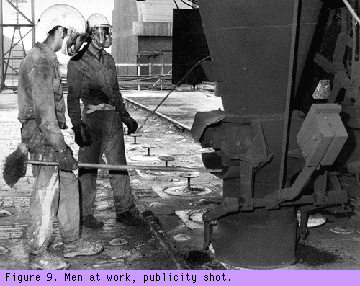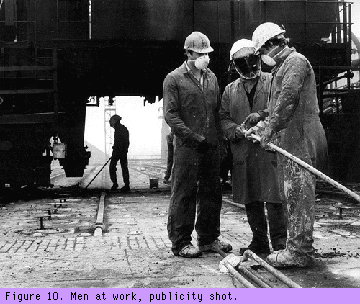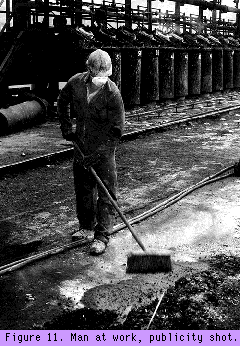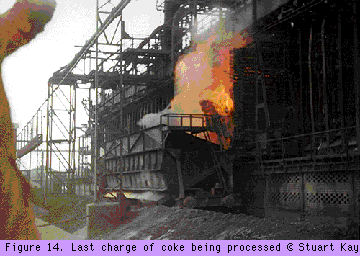
Making Coke, Making People: The Recording of Avenue Coking and Chemical Works, Chesterfield, England.
A. Badcock,
ARCUS -- Archaeological Research & Consultancy at the University of Sheffield


Making Coke, Making People: The Recording of Avenue Coking and Chemical Works, Chesterfield, England.
A. Badcock,
ARCUS -- Archaeological Research & Consultancy at the University of Sheffield

Introduction
 This short piece is a reworked version of a paper I gave at the conference of the
Council for North East Historical Archaeology (CNEHA), in Altoona, Pennsylvania in
1997. The paper stemmed from a project I have been working on. My study concerns
the archaeological recording of a mid-twentieth-century coking and chemical
manufacturing works in Chesterfield, England, which is due to be demolished as part of
a larger scheme of development in the area. Through a combination of varied
recording techniques, and by drawing on the particular attributes of this site, I hope to
develop an archaeological approach that will be applicable to other recent industrial
complexes.
This short piece is a reworked version of a paper I gave at the conference of the
Council for North East Historical Archaeology (CNEHA), in Altoona, Pennsylvania in
1997. The paper stemmed from a project I have been working on. My study concerns
the archaeological recording of a mid-twentieth-century coking and chemical
manufacturing works in Chesterfield, England, which is due to be demolished as part of
a larger scheme of development in the area. Through a combination of varied
recording techniques, and by drawing on the particular attributes of this site, I hope to
develop an archaeological approach that will be applicable to other recent industrial
complexes.
In a climate of constant technological change, there is a danger that, as archaeologists, we will get left behind, not in terms of keeping up with the latest software or hardware, but in terms of how we integrate this technology into our archaeological thought and practice. As a result of trying to rectify my woefully inadequate knowledge of the realities and potential of hyper-media in archaeology, I have at least become aware that there is far more on offer than purely 'high-tech' methods of presentation and publication. We would do well to investigate how this technology can be integrated into our practice, even allowing it to help us think differently, perhaps (an issue raised by Kathryn Denning in assemblage 3). The beauty of hyper-media is the potential for creating and presenting a non-linear study. We do not have to conform to the traditional 'aims, method, application and results' format that typifies the vast majority of archaeological reports. Of course, the path of the navigator is still prescribed to a certain extent by the content, but a well designed web site will encourage and facilitate enquiry, and one person's reading will be different from another's.
Setting the scene
 Avenue Works is located near Chesterfield in the North Midlands, England, the heart of
what was once a major coal-producing area. The plant comprises a variety of
structures including ovens, reprocessing works, rail sidings, administrative blocks, and
storage units, and it encompasses 188 hectares (464 acres) of land in total (see Figure 1). It was built
between 1952 and 1956, to produce smokeless solid fuel (coke) from coal for both the
industrial and domestic markets. Innovative design meant that its own by-products,
and some of those from other plants in the region, could be processed on site. The site
lay-out was planned to accommodate a 100 percent increase in production, though in
fact, this expansion never took place, and the plant remained fairly true to its original
ground plan. The production of smokeless fuel became an important aspect of the
post-nationalisation [1] coal industry, and the period during which the Avenue Works was
built and operated represents the final and most sophisticated form of coke production
in the country (Gould 1994) (see Figure 2). Coke production in England has dramatically declined in
recent years, and almost all remaining plants have been demolished; production at
Avenue ceased in 1992 and the works have been disused ever since.
Avenue Works is located near Chesterfield in the North Midlands, England, the heart of
what was once a major coal-producing area. The plant comprises a variety of
structures including ovens, reprocessing works, rail sidings, administrative blocks, and
storage units, and it encompasses 188 hectares (464 acres) of land in total (see Figure 1). It was built
between 1952 and 1956, to produce smokeless solid fuel (coke) from coal for both the
industrial and domestic markets. Innovative design meant that its own by-products,
and some of those from other plants in the region, could be processed on site. The site
lay-out was planned to accommodate a 100 percent increase in production, though in
fact, this expansion never took place, and the plant remained fairly true to its original
ground plan. The production of smokeless fuel became an important aspect of the
post-nationalisation [1] coal industry, and the period during which the Avenue Works was
built and operated represents the final and most sophisticated form of coke production
in the country (Gould 1994) (see Figure 2). Coke production in England has dramatically declined in
recent years, and almost all remaining plants have been demolished; production at
Avenue ceased in 1992 and the works have been disused ever since.
 The promotion of public awareness about and the protection of the huge legacy of
industrial sites in England is a major part of the work carried out by the national body
English Heritage <http://www.english-
heritage.org.uk>. In 1986, English Heritage
created the Monument Protection Programme to review the known archaeological
resource in England and to inform and enhance, national and local protection policies
(English Heritage, forthcoming). Within this programme, a series of strategic national
projects has been commissioned in order to gather information about particular types
of monument or activity. The Coal Industry forms one of these projects, and it is hoped
that through the study of groups of monuments, in both their immediate environs and
their wider landscape context, the most appropriate protection or management
strategies can be implemented. It is as a result of this programme that the Avenue
Works has been identified as being of national importance (see Figure 3). Although the plant is
almost unique and might, under normal circumstances be afforded protection under
Listed Building laws <http://www.english-heritage.org.uk/dminterface/dmindex.asp>, it is
so large that it would be impossible to maintain in its present form; financial constraints
and safety considerations alone prevent the site from being preserved in its entirety.
The recording work, required as part of the planning process [2], will document the plant
before it is demolished.
The promotion of public awareness about and the protection of the huge legacy of
industrial sites in England is a major part of the work carried out by the national body
English Heritage <http://www.english-
heritage.org.uk>. In 1986, English Heritage
created the Monument Protection Programme to review the known archaeological
resource in England and to inform and enhance, national and local protection policies
(English Heritage, forthcoming). Within this programme, a series of strategic national
projects has been commissioned in order to gather information about particular types
of monument or activity. The Coal Industry forms one of these projects, and it is hoped
that through the study of groups of monuments, in both their immediate environs and
their wider landscape context, the most appropriate protection or management
strategies can be implemented. It is as a result of this programme that the Avenue
Works has been identified as being of national importance (see Figure 3). Although the plant is
almost unique and might, under normal circumstances be afforded protection under
Listed Building laws <http://www.english-heritage.org.uk/dminterface/dmindex.asp>, it is
so large that it would be impossible to maintain in its present form; financial constraints
and safety considerations alone prevent the site from being preserved in its entirety.
The recording work, required as part of the planning process [2], will document the plant
before it is demolished.
'Thinking' people
 Archaeologies of inhabitation seem better developed for earlier, particularly prehistoric
periods (q.v. Barrett 1994), than for the recent historical period. The chance to record a
site of this nature comes rarely, and it provides an unusual opportunity to rethink our
traditional approaches and experiment with different techniques (see Figure 4). There are few
examples to follow, and while this may be somewhat daunting, it is also an exciting
challenge. English Heritage, in consultation with their Industrial Archaeology Advisory
Panel, provided a brief series of techniques that they recommended be applied to this
study. These techniques were:
Archaeologies of inhabitation seem better developed for earlier, particularly prehistoric
periods (q.v. Barrett 1994), than for the recent historical period. The chance to record a
site of this nature comes rarely, and it provides an unusual opportunity to rethink our
traditional approaches and experiment with different techniques (see Figure 4). There are few
examples to follow, and while this may be somewhat daunting, it is also an exciting
challenge. English Heritage, in consultation with their Industrial Archaeology Advisory
Panel, provided a brief series of techniques that they recommended be applied to this
study. These techniques were:
 Through careful consideration of how to apply these methods and possible means of
presenting the results, we will be able to build a meaningful approach to this site.
These are not simply methods by which empirical data can be gathered about a
complex of (empty) buildings (see Figure 5). What I deem to be of utmost importance, and part of the
unique character of a recent archaeological site, is the introduction of memory as an
investigative tool. The creation of an oral historical record should not be seen as a
separate recording method, but should inform and bind the various methodologies
together. Emphasis will be placed on how the extant building remains were caught up
in, and helped structure, the human experiences of working in, and living with, a large
industrial complex. This study will investigate the development and role (at local,
regional, and national scales) of a specialised plant within the political and social
climate of the post-nationalisation coal industry, and the subsequent collapse of this
industry.
Through careful consideration of how to apply these methods and possible means of
presenting the results, we will be able to build a meaningful approach to this site.
These are not simply methods by which empirical data can be gathered about a
complex of (empty) buildings (see Figure 5). What I deem to be of utmost importance, and part of the
unique character of a recent archaeological site, is the introduction of memory as an
investigative tool. The creation of an oral historical record should not be seen as a
separate recording method, but should inform and bind the various methodologies
together. Emphasis will be placed on how the extant building remains were caught up
in, and helped structure, the human experiences of working in, and living with, a large
industrial complex. This study will investigate the development and role (at local,
regional, and national scales) of a specialised plant within the political and social
climate of the post-nationalisation coal industry, and the subsequent collapse of this
industry.
 Instead of thinking about the space the buildings define, it will help to consider the
processes and activities that took place within those spaces. The idea of recording
industrial processes, as opposed to recording simply the buildings themselves, is not
new; Malaws (1997) gives an excellent account of the theory, methods, and reality of
recording the Taff Merthyr Colliery in South Wales. The site was still operating at the
time, and so provided the surveyors with the kind of detail that we as archaeologists
usually struggle to obtain (see Figure 6).
Instead of thinking about the space the buildings define, it will help to consider the
processes and activities that took place within those spaces. The idea of recording
industrial processes, as opposed to recording simply the buildings themselves, is not
new; Malaws (1997) gives an excellent account of the theory, methods, and reality of
recording the Taff Merthyr Colliery in South Wales. The site was still operating at the
time, and so provided the surveyors with the kind of detail that we as archaeologists
usually struggle to obtain (see Figure 6).
People making coke...
A building's form, function, and space each has meanings in the field of social relations, each is capable of signifying who we are, to ourselves in society and in the cosmic scheme of things. And each speaks of both power and bond relations. (Markus 1993: 30).
 The seemingly overt function of particular buildings within the complex may hide from
view the more subtle activities, assumptions and knowledges that were taking place and
being formed in these areas. During the collection of some of the documentary material
for the archive, these undercurrents became more apparent. The material collected
included a selection of works records, original promotional documents, and a large
collection of photographs taken by one of the Works Managers, Mr Stuart Kay, over a
period of several years (see Figure 7).
The seemingly overt function of particular buildings within the complex may hide from
view the more subtle activities, assumptions and knowledges that were taking place and
being formed in these areas. During the collection of some of the documentary material
for the archive, these undercurrents became more apparent. The material collected
included a selection of works records, original promotional documents, and a large
collection of photographs taken by one of the Works Managers, Mr Stuart Kay, over a
period of several years (see Figure 7).
 There are immense numbers
of plans, charts, and technical drawings which document
the original design of the Works, and changes that were made to them (see Figure 8). Schematic
diagrams relate chemical processes to particular buildings or installations, indicating
different activity areas and routes of movement. However, it is perhaps only through
the oral evidence that we will know how the 'mapped reality' was realised on the
ground. Can we identify unmapped changes to original designs? Were there any makeshift
alterations or non-standard procedures in operation?
There are immense numbers
of plans, charts, and technical drawings which document
the original design of the Works, and changes that were made to them (see Figure 8). Schematic
diagrams relate chemical processes to particular buildings or installations, indicating
different activity areas and routes of movement. However, it is perhaps only through
the oral evidence that we will know how the 'mapped reality' was realised on the
ground. Can we identify unmapped changes to original designs? Were there any makeshift
alterations or non-standard procedures in operation?
 Some of the archive files
contain figures detailing the output of the plant, efficiency ratings
and general running costs (see Figure 9). While these rather dry sets of empirical
data may seem dull or uninspiring, they can help us to focus on the site
in different ways. They can extend our view, enabling us to build up an
idea of the contribution of production at a regional and national scale.
We can compare the production at Avenue Works with that of other plants
and think about how it relied upon and fed different kinds of industry.
Likewise, these data can draw our view inwards, to more immediate
surroundings. Wage lists, incomings and outgoings make us think about
the impact that the closure of the works would have had on the local
economy. These figures are the tangible remnants of management and
control, and without a doubt featured in the decision to close the plant
down.
Some of the archive files
contain figures detailing the output of the plant, efficiency ratings
and general running costs (see Figure 9). While these rather dry sets of empirical
data may seem dull or uninspiring, they can help us to focus on the site
in different ways. They can extend our view, enabling us to build up an
idea of the contribution of production at a regional and national scale.
We can compare the production at Avenue Works with that of other plants
and think about how it relied upon and fed different kinds of industry.
Likewise, these data can draw our view inwards, to more immediate
surroundings. Wage lists, incomings and outgoings make us think about
the impact that the closure of the works would have had on the local
economy. These figures are the tangible remnants of management and
control, and without a doubt featured in the decision to close the plant
down.
 The changing 'image' of the Works is also something that is apparent in the archive
material. My favourite document is a promotional brochure produced by the National
Coal Board in 1956 which presents the clean, efficient and technical face of the works
to the public. The Board was understandably proud of this engineering achievement,
stating that 'this scientifically planned and integrated smokeless fuel and chemical
works is undoubtedly one of the finest in the world' (1956). Constructed over a period
of four years in the 1950s, the Works cost ten million pounds to complete (see Figure 10). The
brochure includes descriptions and images of pristine equipment and new site
buildings, emphasising the clean bright colours of the myriad pipes and towers (Figures 3 and 4). There
are plenty of dials and generators and astonishing perspectives (Figures 5 and 6). The centre page
shows a schematic three-dimensional aerial view of the entire Works, which isolates
the site from its landscape context; there are no hills or houses to be seen, no spoil
heaps or smoking chimneys. It is the very model of cleanliness and
efficiency.
The changing 'image' of the Works is also something that is apparent in the archive
material. My favourite document is a promotional brochure produced by the National
Coal Board in 1956 which presents the clean, efficient and technical face of the works
to the public. The Board was understandably proud of this engineering achievement,
stating that 'this scientifically planned and integrated smokeless fuel and chemical
works is undoubtedly one of the finest in the world' (1956). Constructed over a period
of four years in the 1950s, the Works cost ten million pounds to complete (see Figure 10). The
brochure includes descriptions and images of pristine equipment and new site
buildings, emphasising the clean bright colours of the myriad pipes and towers (Figures 3 and 4). There
are plenty of dials and generators and astonishing perspectives (Figures 5 and 6). The centre page
shows a schematic three-dimensional aerial view of the entire Works, which isolates
the site from its landscape context; there are no hills or houses to be seen, no spoil
heaps or smoking chimneys. It is the very model of cleanliness and
efficiency.
 What is missing from this brochure is the people. There is only one photograph of a
person, who is poring over a plan, but we certainly know that he did not run the plant
by himself. Of course, promotional material has a specific function, and it would make
no sense if it presented anything other than a positive image. It tells us something
about the desire of the National Coal Board to inform people; it almost seems as if they
were not promoting a product as much as a technical achievement. The context of
post-war Britain is important here -- ten million pounds for a construction project does
not seem a large sum today, but in Britain, food rationing had only just ceased and the
brochure vocalises this massive investment in the infrastructure of the country. The
image of the Works has also played an important part in the history of the plant's
development and decline (see Figure 11). The working reality of the plant was not, as we know, the
clean and colourful ideal promoted in the brochure, and as time went on, efficiency
decreased, coupled with an increase in pollution.
What is missing from this brochure is the people. There is only one photograph of a
person, who is poring over a plan, but we certainly know that he did not run the plant
by himself. Of course, promotional material has a specific function, and it would make
no sense if it presented anything other than a positive image. It tells us something
about the desire of the National Coal Board to inform people; it almost seems as if they
were not promoting a product as much as a technical achievement. The context of
post-war Britain is important here -- ten million pounds for a construction project does
not seem a large sum today, but in Britain, food rationing had only just ceased and the
brochure vocalises this massive investment in the infrastructure of the country. The
image of the Works has also played an important part in the history of the plant's
development and decline (see Figure 11). The working reality of the plant was not, as we know, the
clean and colourful ideal promoted in the brochure, and as time went on, efficiency
decreased, coupled with an increase in pollution.
 A very powerful set of images was taken in the mid 1980s as part of a 'clean-up'
campaign, designed to show that the plant could still operate efficiently and could
reduce pollution and emissions (Stuart Kay, pers. comm.) (see Figure 12). These photographs are the
direct result of concern with the public image of the Works and part of a statement to
prove that the accumulated grime of the last twenty years could be defeated. They are
a reflection of a growing concern with environmental issues, and, perhaps, a direct
response to pressures from a Conservative government that was hitting the coal
industry hard (Figures 9-11). I like these pictures very much, and even though they are as staged as
those in the National Coal Board brochure, they somehow seem more honest. The
plant in these pictures needs the people that are working there.
A very powerful set of images was taken in the mid 1980s as part of a 'clean-up'
campaign, designed to show that the plant could still operate efficiently and could
reduce pollution and emissions (Stuart Kay, pers. comm.) (see Figure 12). These photographs are the
direct result of concern with the public image of the Works and part of a statement to
prove that the accumulated grime of the last twenty years could be defeated. They are
a reflection of a growing concern with environmental issues, and, perhaps, a direct
response to pressures from a Conservative government that was hitting the coal
industry hard (Figures 9-11). I like these pictures very much, and even though they are as staged as
those in the National Coal Board brochure, they somehow seem more honest. The
plant in these pictures needs the people that are working there.
 The photographs taken by Stuart Kay are a really valuable contribution to the archive.
They capture the diverse nature of the plant through different seasons, weather and
working conditions, and they were taken for a whole variety of different reasons (see Figure 13). Some
are general overviews, some show particular buildings, others show people at work or
at rest (Figure 12). At last an impression of a working plant comes into view. Concepts of gendered
space emerge; out of several hundred images, the only picture of a woman shows an
administrative office interior (Figure 13). This may reflect bias in the photographic record, but it
may also illustrate the structure of the work force. While I do not yet know the
proportion of men and women employed at the Works, I suspect their (?'traditional')
roles were fairly clearly defined in both functional and spatial terms. This photograph
also reminds us to investigate the relationship between labourer workforce and
management -- who had access to what? How was activity monitored on site? Were
surveillance cameras in operation? Were working schedules started and finished with
audible signals? How did it smell?
The photographs taken by Stuart Kay are a really valuable contribution to the archive.
They capture the diverse nature of the plant through different seasons, weather and
working conditions, and they were taken for a whole variety of different reasons (see Figure 13). Some
are general overviews, some show particular buildings, others show people at work or
at rest (Figure 12). At last an impression of a working plant comes into view. Concepts of gendered
space emerge; out of several hundred images, the only picture of a woman shows an
administrative office interior (Figure 13). This may reflect bias in the photographic record, but it
may also illustrate the structure of the work force. While I do not yet know the
proportion of men and women employed at the Works, I suspect their (?'traditional')
roles were fairly clearly defined in both functional and spatial terms. This photograph
also reminds us to investigate the relationship between labourer workforce and
management -- who had access to what? How was activity monitored on site? Were
surveillance cameras in operation? Were working schedules started and finished with
audible signals? How did it smell?
 Perhaps most poignant are his pictures of the last working day at the plant. In
September of 1992, the last charge of coke was processed. Figure 14 shows the
charge being pushed from the oven before being moved to the quenching tower to be
doused in water. For those watching, this must have been an emotional time (see Figure 15). Avenue
Works closed shortly afterwards in October 1992.
Perhaps most poignant are his pictures of the last working day at the plant. In
September of 1992, the last charge of coke was processed. Figure 14 shows the
charge being pushed from the oven before being moved to the quenching tower to be
doused in water. For those watching, this must have been an emotional time (see Figure 15). Avenue
Works closed shortly afterwards in October 1992.
Closure
 Archaeology has an active role to play in the creation of even our most recent
histories. I hope we will achieve a more socially informed approach to a huge
industrial complex by carrying out this work. We need to gain a picture of a
working plant, one that operated day and night, that produced smells and sounds
which escaped the site's boundaries, and involved a work force for 24 hours of
the day. The differing human perceptions of the structures we build, inhabit and
work in are important questions being asked by archaeologists today. If such
questions are being asked of earlier material, which has often left only the
slightest traces in the ground, we are surely in a privileged position to be working
with a complex that was in operation entirely within living memory. These
memories are a part of the fabric of the buildings themselves.
Archaeology has an active role to play in the creation of even our most recent
histories. I hope we will achieve a more socially informed approach to a huge
industrial complex by carrying out this work. We need to gain a picture of a
working plant, one that operated day and night, that produced smells and sounds
which escaped the site's boundaries, and involved a work force for 24 hours of
the day. The differing human perceptions of the structures we build, inhabit and
work in are important questions being asked by archaeologists today. If such
questions are being asked of earlier material, which has often left only the
slightest traces in the ground, we are surely in a privileged position to be working
with a complex that was in operation entirely within living memory. These
memories are a part of the fabric of the buildings themselves.
Copyright © A. Badcock 1998


Copyright © assemblage 1998